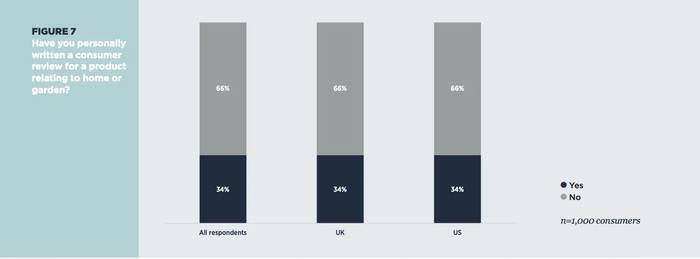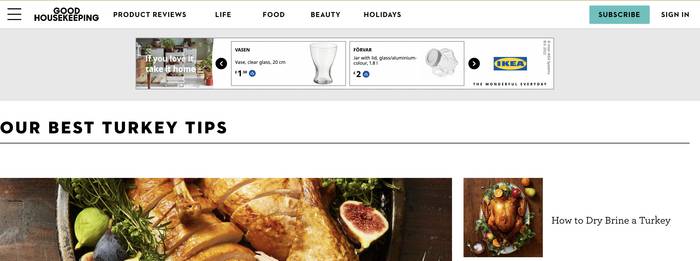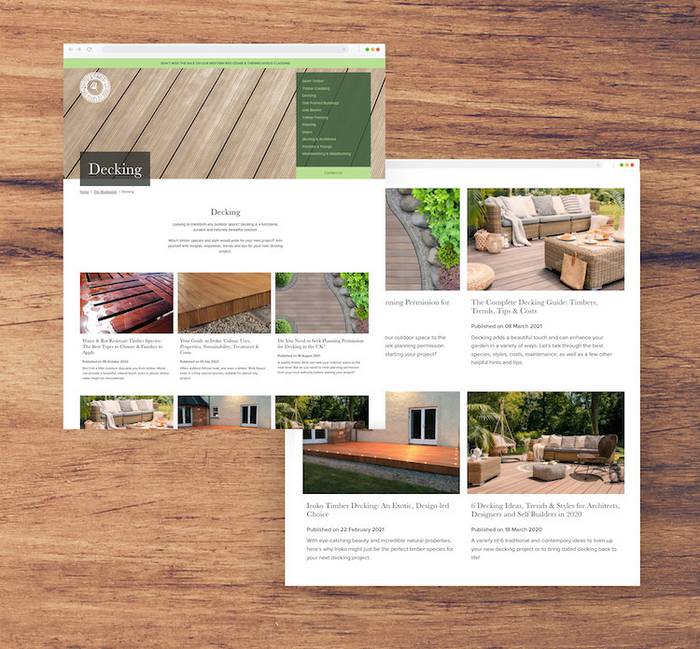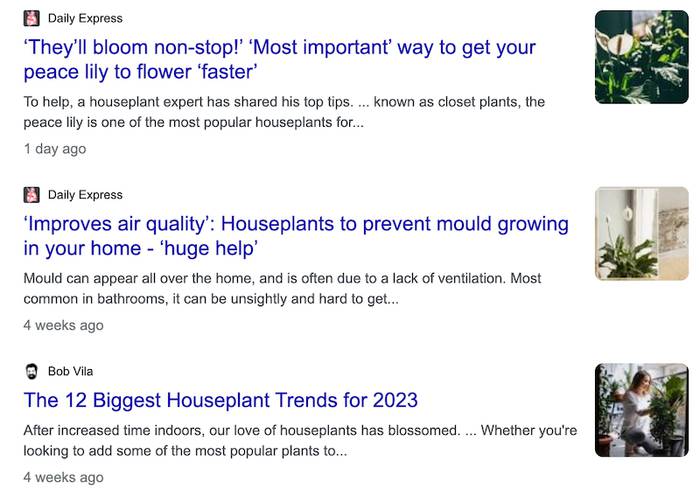As the global economy went into a tailspin, one of the shining stars over the past few years has been the home and garden sector.
Brits have gained a true pandemic-induced passion for home improvement, and forecasts predict that it’s a trend set to continue.
From £37 billion in 2020, the home sector in the UK — including homewares, plants, outdoor living products and the like — is predicted to grow to £44.2 billion by 2025, with online sales rising by 6.6% in the same period.
Despite the pressure of inflation causing our pursestrings to tighten somewhat, we’re still not quite ruling out those little comforts. We still want to make our homes our sanctuaries.
To succeed in an increasingly competitive sector, home and garden brands need to make the right moves to market themselves.
Marketing tactics & tips for home & garden brands
Be sure to use post-purchase email workflows to encourage reviews and user-generated content. Across your website and social media (whether organic or paid), focus on powerful, inspirational visual content. Consider display, Pinterest and YouTube advertising, whilst delivering useful, informative content to boost your SEO. With the focus on visual, don’t neglect website image optimisation, either.
Use email to generate user reviews
When it comes to home and garden purchases, few factors are more influential than reviews. According to Trustpilot, a staggering 79% of Amazon shoppers often check third-party seller ratings before buying.
Therefore, it’s imperative that you work hard to cultivate these all-important reviews. One great way to do this is through the use of a post-purchase email flow.
It’s a wasted opportunity to just send a single ‘thank you’ email. Instead, make sure to follow this with an email asking for feedback on the product, in the form of a review! This not only shows the customer that you care what they think, but also gives you an excellent opportunity to gather some of those sweet, sweet stars.
Now, it’s tempting to be sceptical here — you may presume it’ll be ignored (oh, what we’d do to enjoy higher open and click through rates…). But, when it comes to your sector, Trustpilot research shows that over a third (34%) have personally written reviews for products in the home and garden industry!
Be as visual as possible
In a sector that’s inherently visual with a huge element of personalisation, sparking your customer’s imagination — inviting them to imagine your ranges in their homes — takes you that step closer to converting.
Show, don’t just tell. As consumers have plenty of opportunity to shop around, make sure to harness the power of photography, stop motion and video to full effect for your brand. If you can, use augmented reality and apps to give users the chance to see your product in their home.
Before you get hold of a camera, take time to style your products well. Be sure to show it in its natural environment, creating a look or themes that might appeal to your audience.
You could even use video for ‘how tos’. Show your audience how to assemble your product or style it, potentially with some of your other products that might complement the product in question.
Be as descriptive as possible on your product pages, too. Providing dimensions and other key details will help customers to plan your products in their homes — there’s nothing as frustrating as wondering whether something will fit, so providing information clearly and prominently will remove a barrier to conversion.
As part of providing your customers with more visuals, user-generated content should be a powerful tool in your arsenal…
Showcase your products in situ with user-generated content
Take authenticity up a notch. User-generated content provides unrivalled context and acts as a strong trust signal — and big brands are all up to it.
In the same way that home and garden customers regularly turn to reviews to help them in their decision making, 90% of consumers say UGC holds more influence over their purchase decisions than promotions or search engine results.
Again, the aim should be to show how your ranges will work. You’ll probably have seen websites that provide an image feed towards the end of the product page (usually below the product details), showing how customers have used it in their home or garden.
How, though? I can’t just magic UGC out of thin air…
Well, just ask, we say.
This could be done as part of your post-purchase email flow, like we mentioned earlier. As well as for requesting reviews, post-purchase represents a great opportunity to maximise your pool of vital user-generated content. Ask the proud new owners of your product(s) to post a picture on social media, perhaps using a relevant hashtag. If you don't ask, you don't get!
Try not to worry if the content isn’t ultra-slick, polished or professional, particularly when it’s UGC. In fact, authentic, ‘low-fi’ shots can hold just as much sway, particularly in those ‘here’s how our customers are using it’ image feeds.
Use programmatic advertising to show ads against relevant and engaging content
Where better to place an ad of your new fancy coffee machine than on an article in Good Housekeeping talking about kitchen appliances? By using contextual targeting, you can ensure your display ads appear on the sites of content that your target customers are likely to be consuming.
This can also be an opportunity to test new, exciting ad formats to catch the reader’s eye. Platforms such as Stackadapt offer the ability to test interactive formats, such as scratch and reveal or playable ads.
Engage with your audience on YouTube
More and more consumers are turning to YouTube to help them make decisions on new purchases.
From watching reviews of new products to unboxing videos — did you know that over 90,000 people type ‘unboxing’ into YouTube every month? — your home and garden audience is most definitely there. Why not engage with these users while they are on this platform by implementing a YouTube advertising strategy?
You can choose to target these ads based on video content, ensuring you’re always on show before or during videos on relevant subjects. You can also create a custom audience that represents your ideal customer.
However you choose to target, ensure your video ad is short and compelling, getting your brand message across to the user as early as you can.
If you have the time and resources, consider creating multiple videos that can be used in an ad sequence. A series of videos can help you to tell a story to the user, who will see the ads in a specific predetermined order. According to Think With Google, ad sequences have been proven to increase brand recall by 74% when compared to individual 30 second videos.
Consider seasonality in your paid marketing strategy
Take a look at your past sales data as well as industry insights and trends. For example, a quick check in the Google Ads Keyword Planner reveals that searches for 'garden furniture' increase by 83% on average in April compared to March.
In contrast, searches for ‘coffee machines’ start to grow in October and reach a peak in November and December, no doubt influenced by Black Friday and the run up to Christmas.
Make sure your paid budget reflects these market changes and seasonal trends to ensure you don't miss out on vital traffic and purchase intent.
Consider a brand ambassador or influencer marketing strategy
When it comes to delivering that all-important inspiration, a brand ambassador or influencer might be able to help you reach new audiences. Dulux is one such brand that does this excellently, enlisting the services of Dr Alex George in 2022.
A brand ambassador or influencer helps to humanise your brand through association with popular, influential figures. Use them to create video content that invites users to imagine how your product works in real life.
Create content hubs to address your audience’s needs
In the home and garden industry, your consumers may spend days, weeks or months researching different topics, products and solutions. A frequent recommendation of ours for any of our clients where this type of search journey occurs (and where content creation is crucial) is to consider a ‘content hub’.
Content hubs are an exemplary means of structuring and ordering content on particular topics. They benefit user experience, inviting website visitors to explore content by topic and discover more about what interests them.
But just as importantly, content hubs benefit search visibility by improving the semantic relationships between pages and boosting your topic authority, helping position you as an expert on your chosen topics. This can improve the chances of your website ranking for other searches on these themes, including your sales-critical product pages.
We did precisely this for Duffield Timber, who sell cladding, decking, fencing, flooring and other timber home improvement products. The results of the content hub we created for the client were spectacular.
Focus on image optimisation
Since so much of what goes in our homes is driven by how it looks, it pays to ensure your images rank well in Google image search. Pinterest boards have been a great source for users seeking home inspiration, and while we’d advocate creating some of those to benefit from the authority and ranking potential of Pinterest, this doesn’t mean you should neglect your own images.
To make your images more discoverable in search, we’d recommend:
Adding structured data
Optimising for speed
Using high quality photography
Including descriptive titles, descriptions, filenames, and text for images
Using descriptive alt text
Creating an image sitemap
Consider a local search strategy
Given the nature of the home and garden sector, some users will prefer to deal with someone local to them. This is especially true when it comes to being able to visit local designers or showrooms, for example if you’re considering a new kitchen.
If this applies to you, ensure you create and optimise your Google business profile to give you the best chance of ranking in local search results.
Also, make sure to optimise your site for search terms with local intent, build citations with tools like Whitespark, encourage customers to leave reviews and reply to those that have already left them — especially the negative ones (to show you care!) — and apply local business schema.
Don’t be shy about detail on your product pages
Whilst it’s important to show in the home and garden sector, don’t neglect to tell.
Talk about uses, USPs, features and solutions provided by your products on the product pages. By doing this, you’ll naturally create a richer, more in-depth and more informative resource — page optimisation like this not only reassures users, but signals to Google that your page is useful to users, increasing the chances of it ranking.
Let’s say you sell timber cladding. One of your top performers is Western Red Cedar in a V-groove profile. Spare no detail about the virtues of the species — its beauty, durability and applicability for outdoor use. Talk too about the profile of the cladding; how it looks and performs.
Google’s helpful content update aims to reward content that provides users with a satisfying experience. Results pages can be highly competitive, so making sure your key product pages are optimised will give you the best chance to rank as highly as possible.
Be wary of over-optimising your pages with repetitive, unnatural references to the product, though. Gone are the days of so-called ‘black hat’ keyword-stuffing strategies; Google is increasingly intelligent and wants to see content created ‘for people, not for search engines’. Try to avoid generic copy that’s repeated across multiple pages — duplicate content is always a no-no.
Tell a news story using your experts or data
People like to consume content that relates to them and their homes. Your brand can harness this by creating news items and pitching them to press.
How often do you see news stories relating to the home and garden sector? Think headlines about the ‘most Instagrammable house plants’, ‘Britain’s most popular carpet colours’ or ‘top interior design trends for next year’.
So, do you have some interesting internal sales data that might be able to tell a story about our shopping habits? Does your internal team have some pertinent points to make about upcoming trends in the home and garden sector? Leverage these ‘hooks’ to your advantage — create a press release to secure coverage in industry trade publications or local, regional or national outlets.
Brand references in the press are clearly positive for awareness, but they can also bestow benefits for your SEO. Links from good domains to your website infer that your website is an authoritative, credible resource — and it’s therefore more likely to be ranked higher by Google.
Create inspirational, savable visual content for your social feeds
When contemplating your brand’s social media — both paid and organic — it’s all about inspiration. Try to create content that your audience will want to save or send to their partners as inspiration for that next house plant, rug, decking project, garden shed or wall colour.
(psst, whilst we’re on this, be sure to check out our blog about the best ways to level up your paid social creative.)
‘Saveable’ content is something that your audience will want to store, share with friends and refer back to, time and again. As highly visual platforms, this pertains particularly to Instagram, TikTok and Pinterest.
So, populate your social channels with eye-catching, purchase-inducing content. Tell a story and inspire people using your products.
Explore Pinterest’s new Idea ads
Pinterest is a unique, valuable platform for home and garden brands. People visit it with the intention to research, plan and eventually buy. So, Pinterest’s newly-introduced ‘Idea’ ads are certainly worth your consideration. This allows you to create immersive, full-screen ads for storytelling, something which can be maximised with paid partnerships with expert creators to further your reach.
Tag your products in your social media ads
If you’re using lifestyle shots, this can really help customers find what they’re looking for. Facebook, TikTok, Pinterest and Instagram allow you to tag your products in your posts; this can be a simple way of nudging people towards the checkout. Make it as simple as possible for users to invest in your brand.
Highlight those little USPs
Like many industries that sell direct-to-consumer, home and garden can be really competitive. Therefore, we’re sure you don’t really need us to tell you the importance of highlighting your USPs: whether they relate to the product or your brand. This might be as simple as making it clear that you offer free delivery and returns.
Nail your brand messaging as consumers’ pursestrings tighten
As we’ve established, home and garden purchases are on the rise and since the pandemic — we’ve all found more and more interest in making our spaces work just right for us. But in 2023 and beyond, ‘on a budget’ is fast becoming the term of the year as costs rise.
When working on your brand, aim to:
Be consistent in your messaging — what are you offering, to whom? Focus on your key audiences and repeat purchasers as they are more likely to be back. Revert back to your mission and values here — what is your core offering and how can you communicate that in today's market?
Encourage repeat custom and loyalty — create offers, content and other types of media that speak to your already converted audiences. Now, more than ever, you want to retain recognition of your brand’s voice in a crowded marketplace. Your customers will gravitate to those they have enjoyed spending with before, to stay within your brand guidelines.
Be mindful of your tone in a challenging marketplace — the cost of living crisis can pose an opportunity for brands to build their trust with sincere, helpful messaging that shows you understand the challenges of your consumers. Consider sharing hints and tips to help with cost, savings, suggesting unique usages of products and so on.
Considering a little home improvement for your in-house marketing strategy?
Come on in, don’t be a stranger — our team of digital marketing experts would be delighted to help!
From high-end homewares and heritage-rich carpentry companies to garden cladding, decking and fencing suppliers, we’ve got experience harnessing all of these tips and tactics to the advantage of brands right across the home and garden sector.
Talk to our team by clicking the ‘get in touch’ button below. Alternatively, give us a bell on 01423 39 69 59, or drop us an email at hello@madebyextreme.com.
Let’s level up your home & garden marketing strategy.
Get in touchPost by

Laura joined Team Extreme in 2017 and through the years has refined her social media skills to become our Paid Social Strategist. She works with our social clients to plan and execute content across a broad range of sectors and channels, helping clients maximise their results and ROI.
Project
Post by

Lucie is our lead on all paid media activity, overseeing our talented paid media team and managing the strategy and implementation of all paid search campaigns across multiple platforms. Fully Google qualified and working directly at Google prior to joining Extreme, there's not much Lucie doesn't know about PPC!
Project
Post by

As our dedicated Social Media Designer, you'll find Sally behind either behind a screen or behind the lense capturing the essense of all the brands we work with. As Extreme's star baker, you might also find her in the kitchen cooking and styling dishes to look mouthwateringly delicious. If you ever find yourself drooling on your phone, that's probably one of Sally's creations!
Project
Post by

Johnny bridges our content and SEO teams, creating and managing strategies that elevate clients' organic search visibility.
Project









